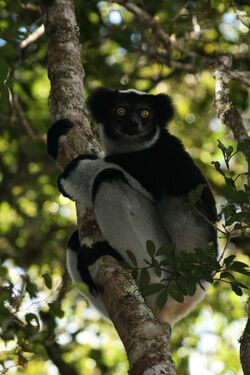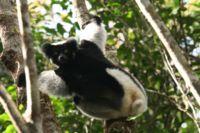Indri indri (Indri): Difference between revisions
imported>Kim van der Linde (species name in lowercase) |
imported>Kim van der Linde m (Indri moved to Indri indri (Indri): per standard naming convention) |
Revision as of 04:48, 24 October 2007

The Indri Indri indri is the largest living Lemur. In the wild, it is found only on the island of Madagascar.
Description
The indri is a diurnal Primate that has a head body length of approximately 64 – 72 cm and a stubby vestigal tail [1][2][3]. Weight ranges between approximately 6kg up to almost 10kg [3]. Coat color varies from predominantly black contrasting with a white pygal patch and paler facial ring, to variegated black and white[3]. Males can be difficult to distinguish from females, but in the Analamazaortra Special Reserve males are slightly larger than females and there is slight dimorphism in color pattern[3].
Behaviour
The indri lives in small family groups[2]. Its movement is described as vertical climbing and leaping and it maintains a preferential upright body posture[3]. The indri has a loud vocalization which has been described as an “eerie wailing song” [3]which can be reminiscent of the singing of some whale species.

Diet
The indri is predominantly a folivore that eats mainly immature leaves, but it also feeds on seeds, fruits and flowers[2][3].
Geographical distribution
The indri may be found in tropical moist lowlands and montane forests of eastern Madagascar[3].
References
- ↑ J. Fleagle (1998). Primate Adaptation and Evolution. Academic Press: New York.
- ↑ 2.0 2.1 2.2 F. Szalay and E. Delson (2001). Evolutionary History of the Primates. Academic Press, New York.
- ↑ 3.0 3.1 3.2 3.3 3.4 3.5 3.6 3.7 3.8 Mittermeier et al. (2006). Lemurs of Madagascar. Conservation International.